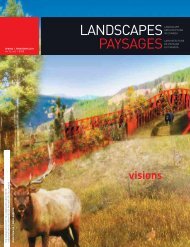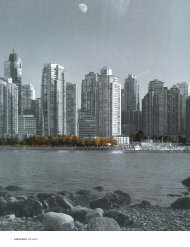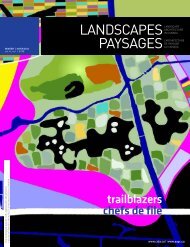time + place temps + lieu - CSLA :: AAPC
time + place temps + lieu - CSLA :: AAPC
time + place temps + lieu - CSLA :: AAPC
Create successful ePaper yourself
Turn your PDF publications into a flip-book with our unique Google optimized e-Paper software.
THE LAST WORD | LE MOT DE LA FIN<br />
EQUILIBRIUM<br />
FR_ UNE QUALITÉ D’ÉQUILIBRE<br />
www.aapc-csla.ca<br />
JULIAN SMITH<br />
In October 2009, the newly elected<br />
President of ICOMOS, Gustavo Araoz, presented<br />
a paper in Malta that signaled a paradigm shift in<br />
the heritage conservation field. The reverberations<br />
from that paper, and the debate it engendered, are still<br />
being felt within ICOMOS, UNESCO, and the international<br />
heritage community.<br />
That paradigm shift is from a static to a dynamic view of cultural<br />
heritage. It is about recognizing heritage as a form of cultural expression,<br />
embracing the intangible quality of cultural practice as much as the tangible<br />
reality of artifacts. In culturally-significant <strong>place</strong>s, it is about interweaving ideas<br />
of commemorative integrity with ecological integrity.<br />
In his paper, Gustavo pointed to the 1987 adoption by ICOMOS of the Florence<br />
Charter for the Conservation of Historic Gardens as “the first subtle sign that<br />
the ground was shifting under the heritage community.” Although landscape<br />
architects, historians and conservators could apply ideas of preservation,<br />
restoration and rehabilitation similar to those being used for buildings and museum<br />
objects, they could not freeze these <strong>place</strong>s in <strong>time</strong>. At the end of the day, they<br />
had to search for a quality of equilibrium, of subtle and continuous change that<br />
nonetheless sustained an essential integrity of cultural expression.<br />
The strength of this attitude is evident in emerging conservation approaches for<br />
buildings and objects, for historic neighbourhoods, and for entire urban and rural<br />
historic regions. Cultural landscape theory and practice is the vehicle for much of<br />
this discussion, strongly influenced by global Aboriginal perspectives. The new<br />
UNESCO Recommendation on Historic Urban Landscapes is the first use of a<br />
cultural landscape approach in a major international document. There is still strong<br />
resistance, particularly from architects and object conservators, but it is pretty<br />
clear by now that landscape architects, especially those engaged with culturallysignificant<br />
sites, must continue to take the lead in demonstrating and explaining<br />
the new paradigm. This issue of the Landscapes | Paysages is a case in point. A wellconsidered<br />
landscape approach is key to an ecological understanding, which in turn<br />
is the only way towards true sustainability of both natural and cultural resources.<br />
One of the consequences of a more dynamic view of cultural heritage is the<br />
recognition that appropriate contemporary layers can add richness to existing<br />
<strong>place</strong>s and reflect ongoing viability. This is a shift in the heritage field from an<br />
emphasis on “protection” to an emphasis on “value enhancement,” or what in<br />
French would be called “mise en valeur.” There is the need for creativity within a<br />
framework of existing cultural value. This means a respect for careful research and<br />
documentation, including an understanding of traditional practices, and then the<br />
ability to capture both the tangible and intangible qualities of a <strong>place</strong> in new design<br />
interventions. This means that the conservation and development of culturallysignificant<br />
landscapes – urban, rural, wilderness – will need to draw on the<br />
combined skills of heritage specialists and the best contemporary design skills. We<br />
still need to find the right educational models for developing expertise in this area<br />
of overlap. But clearly for those with these skills the future is wide open.<br />
… from a static to a dynamic view<br />
of cultural heritage… ...d’une vision<br />
statique à une vision dynamique<br />
du patrimoine culturel...<br />
Julian.smith@willowbank.ca<br />
1 LANSDOWNE PARK PLAN (SEE STORY PAGE 42) | 1 PLAN<br />
DU PARC LANDSDOWNE (VOIR L’ARTICLE EN PAGE 42)<br />
PHOTO PHILLIPS FAREVAAG SMALLENBERG<br />
54 LANDSCAPES PAYSAGES






